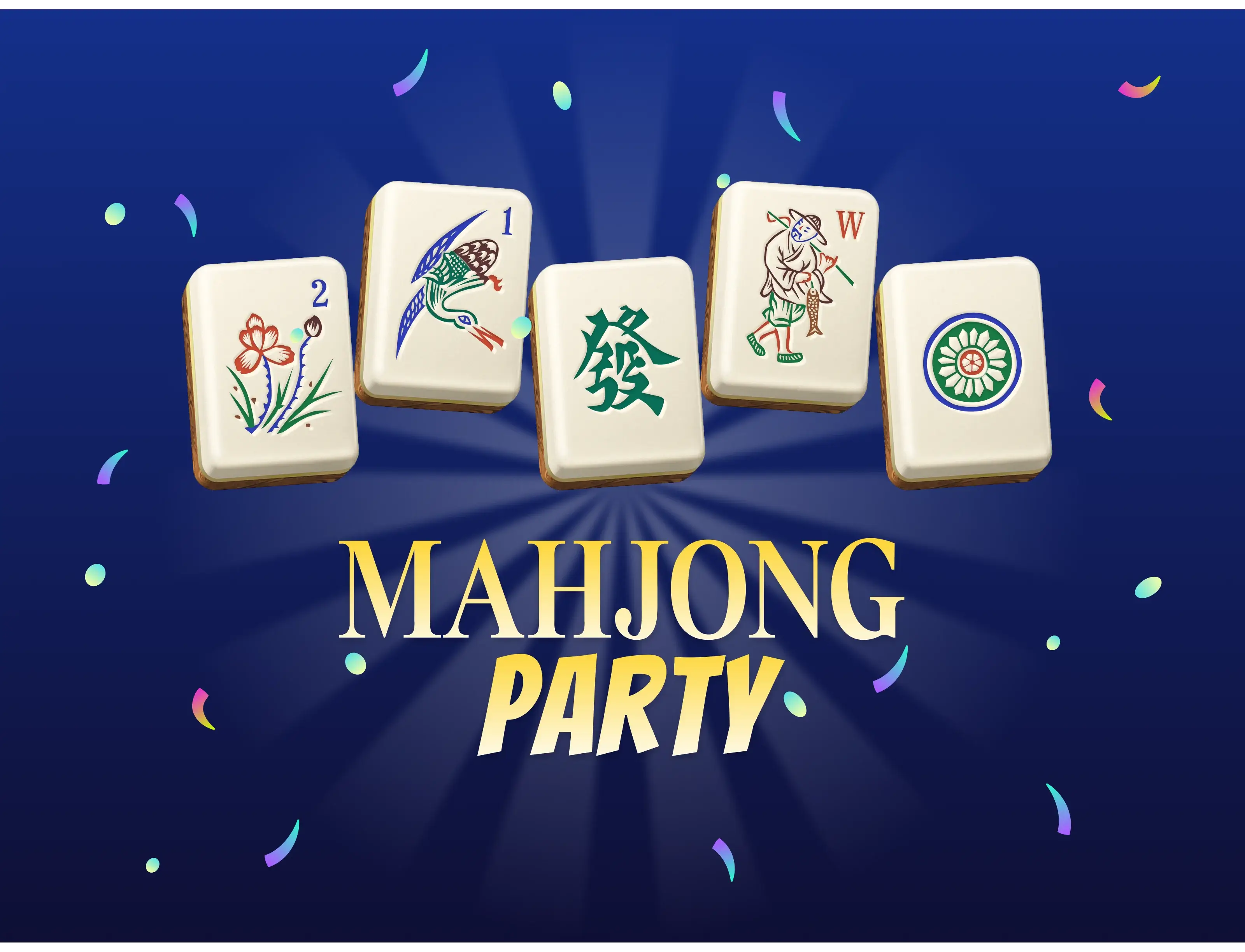Who Solves Puzzles? A Study of the Online Puzzle Game Audience
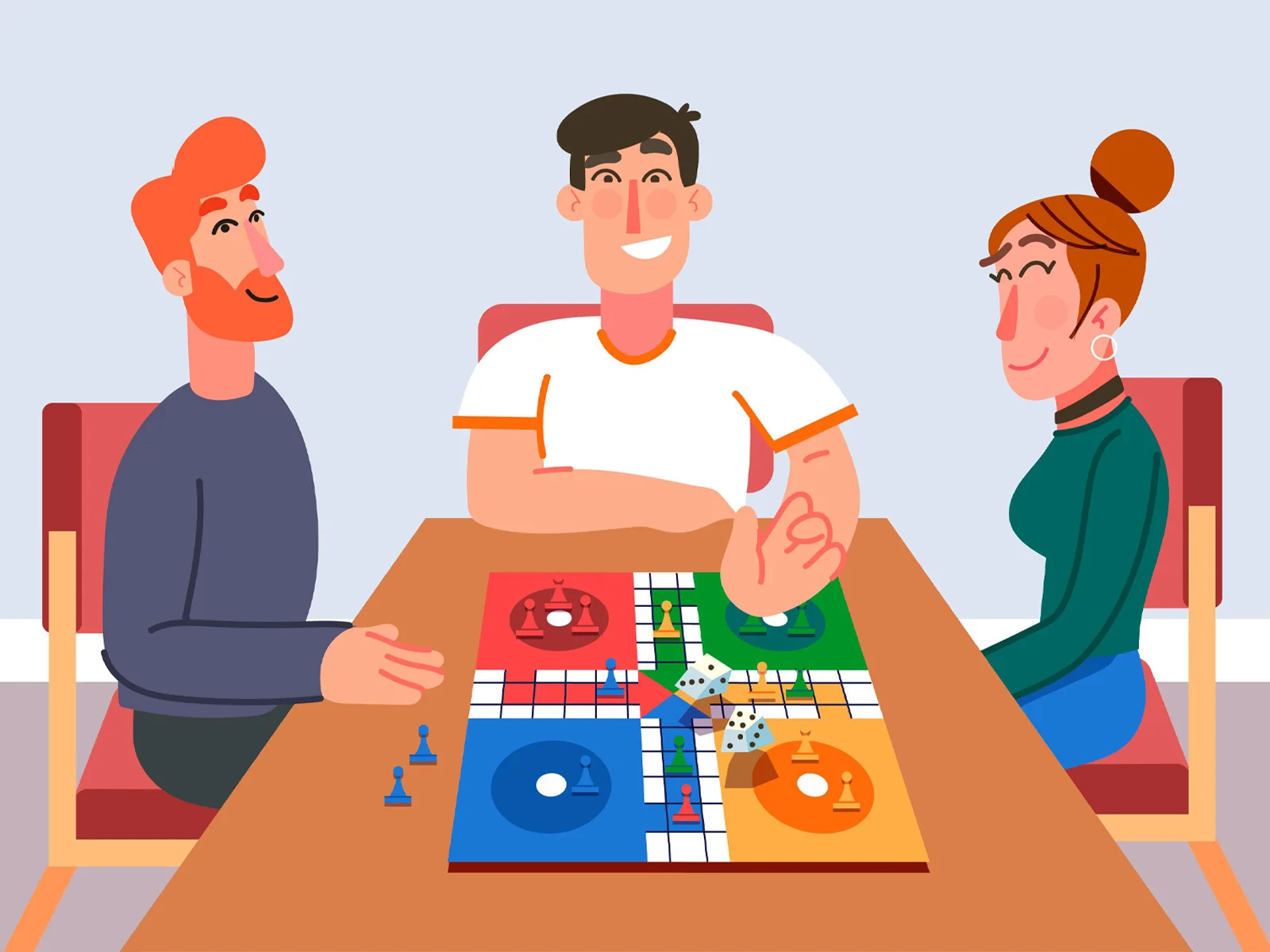
While the world’s media is focused on major headlines such as the Paralympic Games in France, the arrest of Pavel Durov (founder of Telegram), the release of new entertainment films, and reviews of high-profile gaming industry releases like Kingdom Come: Deliverance 2, many game development companies are concentrating on enhancing graphical realism and exploring new gameplay mechanics. The puzzle game genre remains outside the media spotlight, which creates a false impression that this sector of the gaming industry lacks demand among users.
Nevertheless, the market for casual games and puzzles, in particular, is growing every year. Our project team decided to explore the phenomenon of the growing puzzle game audience, its reasons, and attempt to create a general profile of the average online puzzle game player.
Research Objective
The foundation of our research will be the analysis of the audience of the website themahjong.com, which features a solitaire version of the Mahjong game in various variations. The choice of this site was made not only because of the suitable genre but also because the website is regularly updated and shows consistent audience growth.
The aim of our research is to identify the characteristics of the puzzle game website audience and the processes that shape it. To achieve this, we set the following objectives:
- Categorize the audience of online puzzle websites.
- Highlight the factors contributing to the popularity growth of such projects.
- Analyze users' motivations for using these services.
- Create a profile of the average online puzzle game player.
Methodology
As the primary source base, we used anonymous statistics from the online Mahjong game (themahjong.com), obtained via Google Analytics. Specifically, we utilized data on visitors worldwide and from the US in particular who used the service (themahjong.com) from September 1, 2023, to September 1, 2024, as well as user feedback received through the contact form. The statistical data includes the following anonymous information:
- Anonymous data on the total number of users, including the percentage growth compared to the previous period.
- Anonymous data on the countries from which users accessed the site.
- Anonymous data on major cities from which traffic to the site originated.
- Anonymous data on the biological gender of users.
- Anonymous data on age groups.
- Anonymous data on the selected language.
It is important to note that Google Analytics reports have an error margin, which may range from 5% to 15%. This is due to factors such as the use of browser extensions like "Incognito Mode" and the user's internet speed, which affects the loading speed and execution of scripts.
The research methodology is based on statistical methods, as well as methods of historical anthropology, such as comparative analysis and interviews.
Audience of Puzzle Game Websites
There are several ways to categorize the audience of casual game websites. The first and most obvious is grouping users by age. According to available statistics, we can identify the following age groups of users:
- 18-24
- 25-34
- 35-44
- 45-54
- 55-64
- 65+
Based on statistics collected over the year (from September 1, 2023, to September 1, 2024), we can determine that the site themahjong.com was visited by a total of 1,675,745 unique users. Among them, we are unable to consider a significant portion—1,428,995 users—since their age cannot be determined.
Nevertheless, the remaining sample of 246,750 users is still highly relevant. Analyzing the available data, we can highlight the following percentages by age group:
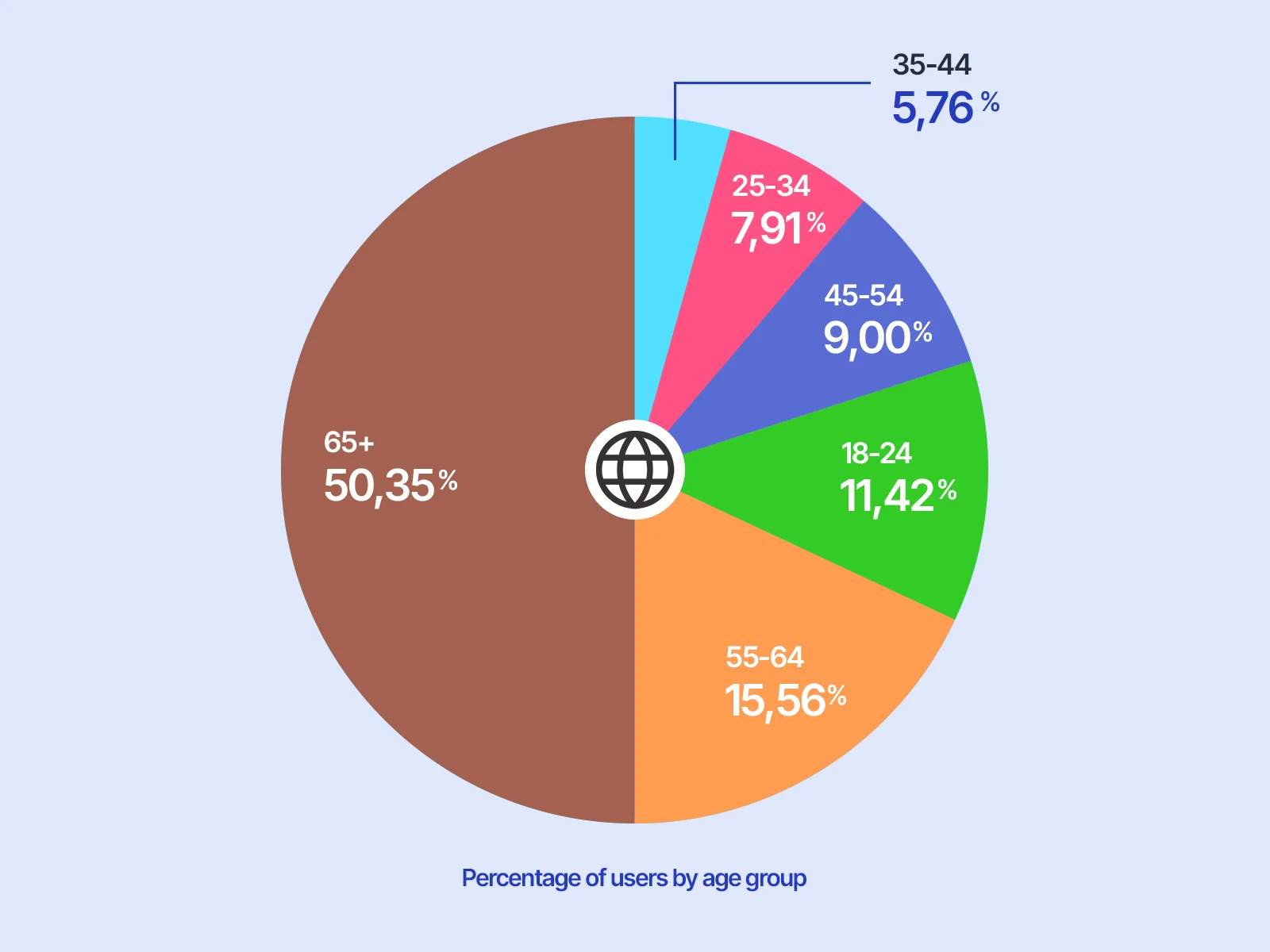
- 18-24: 11,42% (28,171 unique users)
- 25-34: 7,91% (19,512 unique users)
- 35-44: 5,76% (14,219 unique users)
- 45-54: 9,00% (22,216 unique users)
- 55-64: 15,56% (38,390 unique users)
- 65+: 50,35% (124,242 unique users)
According to this data, the largest user group consists of those aged 65+. The smallest group is the 35-44 age range. If we consider the 55-64 and 65+ age groups, which account for the most significant portion of the audience, they collectively make up 65.91% of the total traffic.
If we take a closer look at US user traffic over the same period, we can observe the same trend. According to the statistics, from September 1, 2023, to September 1, 2024, the site was visited by 631,388 unique users from the US, of which we can determine age groups for 104,258 unique users. The data reveals the following distribution:
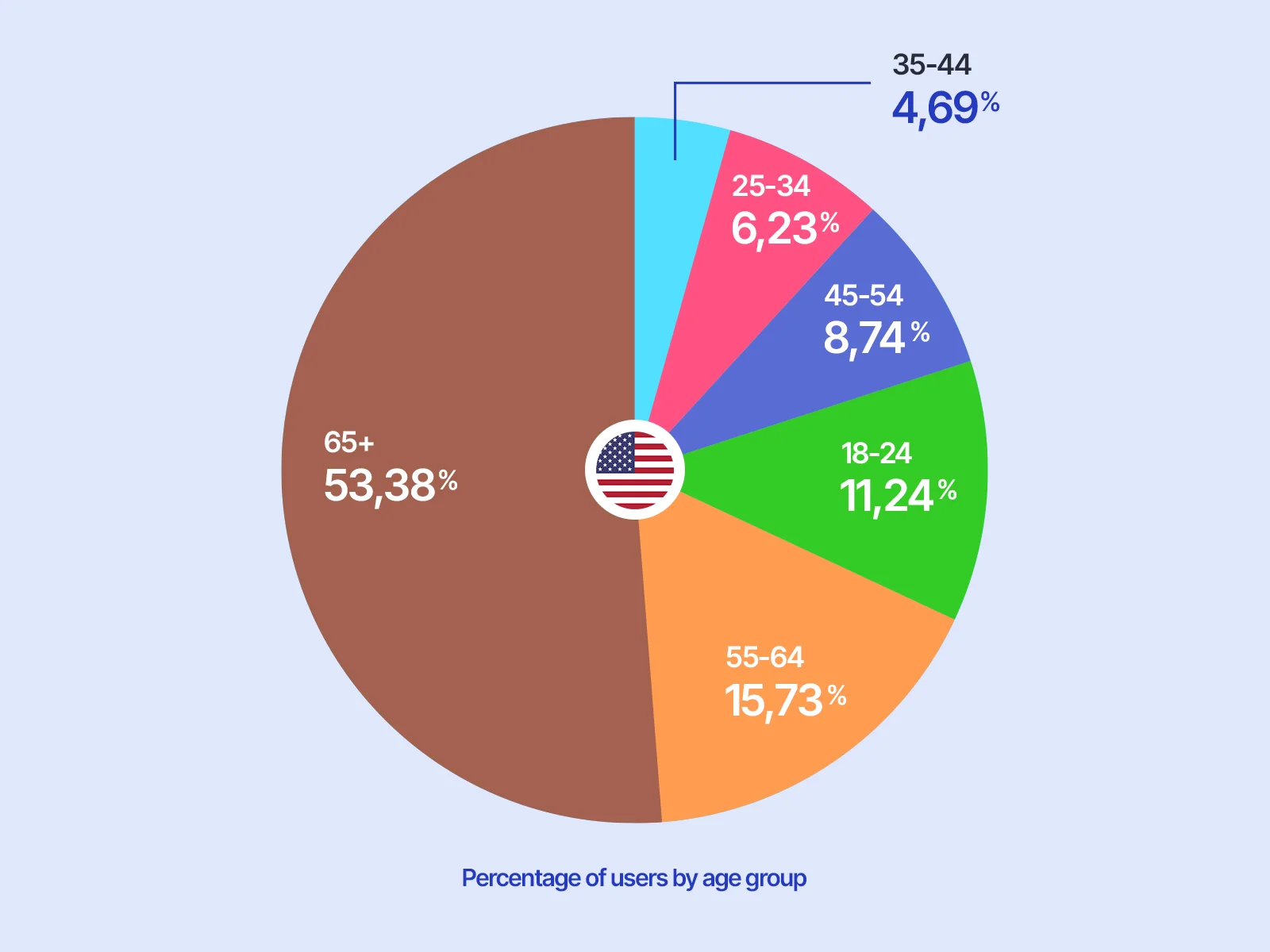
- 18-24: 11,24% (11,718 unique users)
- 25-34: 6,23% (6,492 unique users)
- 35-44: 4,69% (4,886 unique users)
- 45-54: 8,74% (9,116 unique users)
- 55-64: 15,73% (16,397 unique users)
- 65+: 53,38% (55,649 unique users)
As in the global data, we see a significant predominance of users in the "55-64" and "65+" groups. We believe this is due to the fact that these groups mainly consist of seniors who are often retired and living without children, which provides them with more time for personal leisure, including entertainment such as gaming.
This theory is further supported by the data on the least numerous user groups, which include the 25-34, 35-44, and 45-54 age groups. Typically, these age categories consist of users who are working and have families. Based on this data, we can assume that due to full-time employment and the need to dedicate time to family, people in these age groups prefer other leisure activities, such as watching movies on streaming services, and show less interest in casual games and puzzles in particular.
The percentage of users from the 25-34, 35-44, and 45-54 age groups, we can assume based on the statistics of weekday and weekend visits (on weekends, visits from these user groups decrease by 16-20% compared to weekdays), largely consists of office workers. Typically, this category of employees does not have the opportunity to install more resource-demanding games or use streaming services during work hours. However, they do have the chance to restore their mental energy by distracting themselves with pre-installed games or their online equivalents, which casual games fall under.
When it comes to the language preferences of users, the majority are native English speakers or use the language. The top five most numerous languages also include Russian, German, French, and Chinese. Indonesian rounds out the top ten most popular languages. The percentage breakdown is as follows:
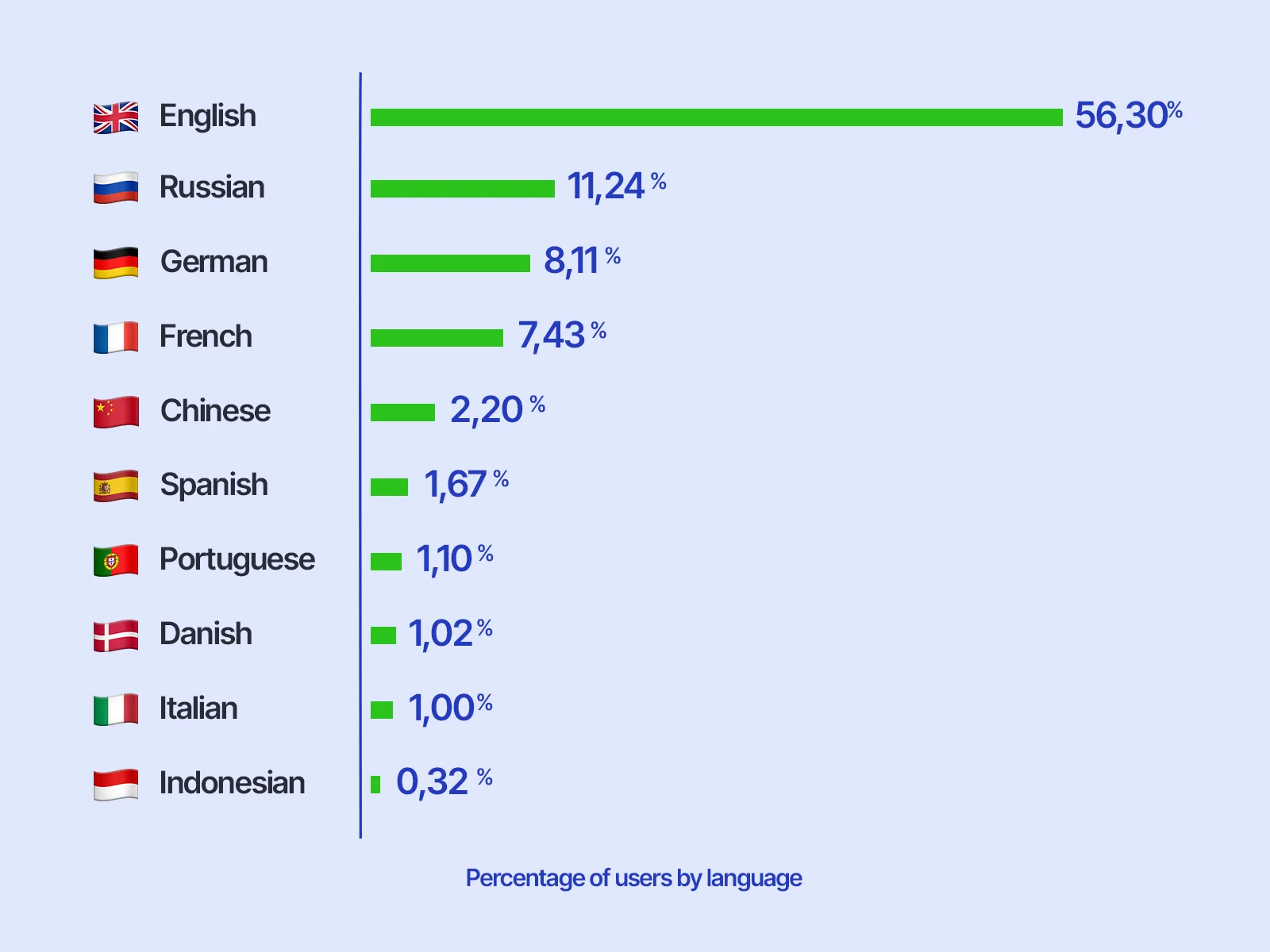
- English: 56,30% (943,454 unique users)
- Russian: 11,24% (188,382 unique users)
- German: 8,11% (135,886 unique users)
- French: 7,43% (124,502 unique users)
- Chinese: 2,20% (36,888 unique users)
- Spanish: 1,67% (28,050 unique users)
- Portuguese: 1,10% (18,434 unique users)
- Danish: 1,02% (17,073 unique users)
- Italian: 1,00% (16,750 unique users)
- Indonesian: 0,32% (5,356 unique users)
It is important to note that this language distribution is not typical and depends on the type of project and its ranking by search engines in different countries. However, when comparing the statistics of themahjong.com with other KraiSoft projects, we can see a significant predominance of English-speaking users (themahjong.com — 56.30%, thesolitaire.com — 49.91%, thesudoku.com — 58.74%, thejigsawpuzzles.com — 65.41%).
The high percentage of English-speaking users can be explained by the significant number of players from countries such as the United States, Canada, the United Kingdom, and Australia, a large portion of whom are native English speakers.
We could assume that this percentage of users is linked to the wealth levels of these countries' populations compared to others. However, it is important to note that a considerable number of wealthy European countries are also among the users of themahjong.com. Most likely, in addition to the overall affluence of these countries and the wealth of the major age groups using the project, this ratio can also be attributed to the population size of these countries and the popularity of casual games as a form of entertainment.
If we look at the chart showing the countries from which users accessed the site, we see the following statistics:
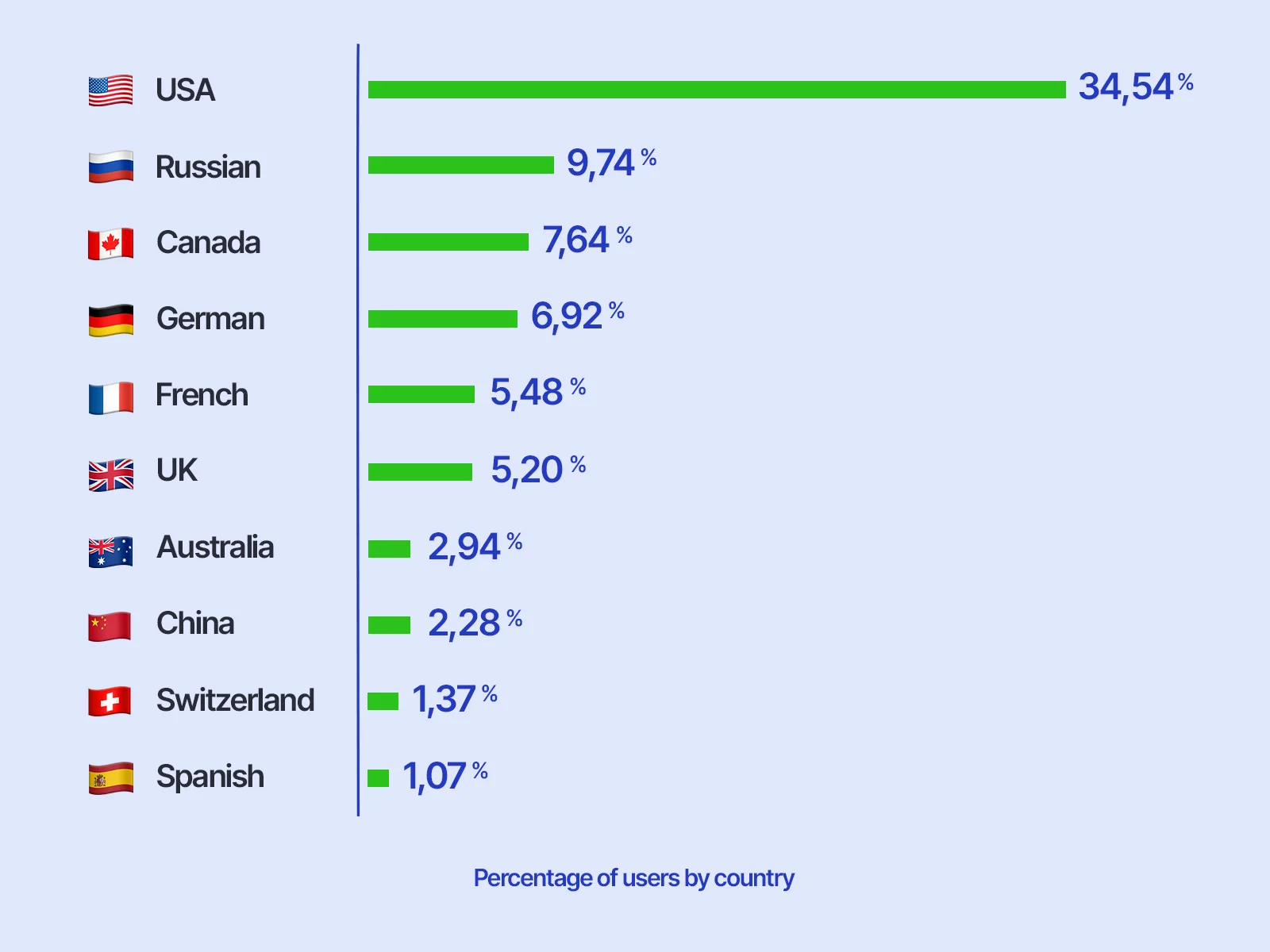
- USA — 34,54% (578,826 unique users | population: 334 million)
- Russia — 9,74% (163,190 unique users | population: 145 million)
- Canada — 7,64% (128,096 unique users | population: 39 million)
- Germany — 6,92% (115,996 unique users | population: 83 million)
- France — 5,48% (91,752 unique users | population: 68 million)
- United Kingdom — 5,20% (87,206 unique users | population: 67 million)
- Australia — 2,94% (49,239 unique users | population: 26 million)
- China — 2,28% (38,147 unique users | population: 1,41 billion)
- Switzerland — 1,37% (22,895 unique users | population: 8,8 million)
- Spain — 1,07% (17,893 unique users | population: 47 million)
According to this data, the percentage of players from predominantly English-speaking countries, which are among the top 10 in terms of site visits, amounts to 49.66% of the total number of users (1,675,745 for the period from September 1, 2023, to September 1, 2024). Meanwhile, densely populated countries such as China account for a small percentage of the total number of users, which overall supports the conclusion that the number of users on such projects is influenced not only by population size but also by the popularity of this type of leisure activity.
When it comes to the biological gender distribution of users, we observe a clear predominance of female players, accounting for approximately 65.55% of the user base. It is important to note that data on this parameter is available for only 232,483 unique users. In more specific terms, the distribution is as follows:
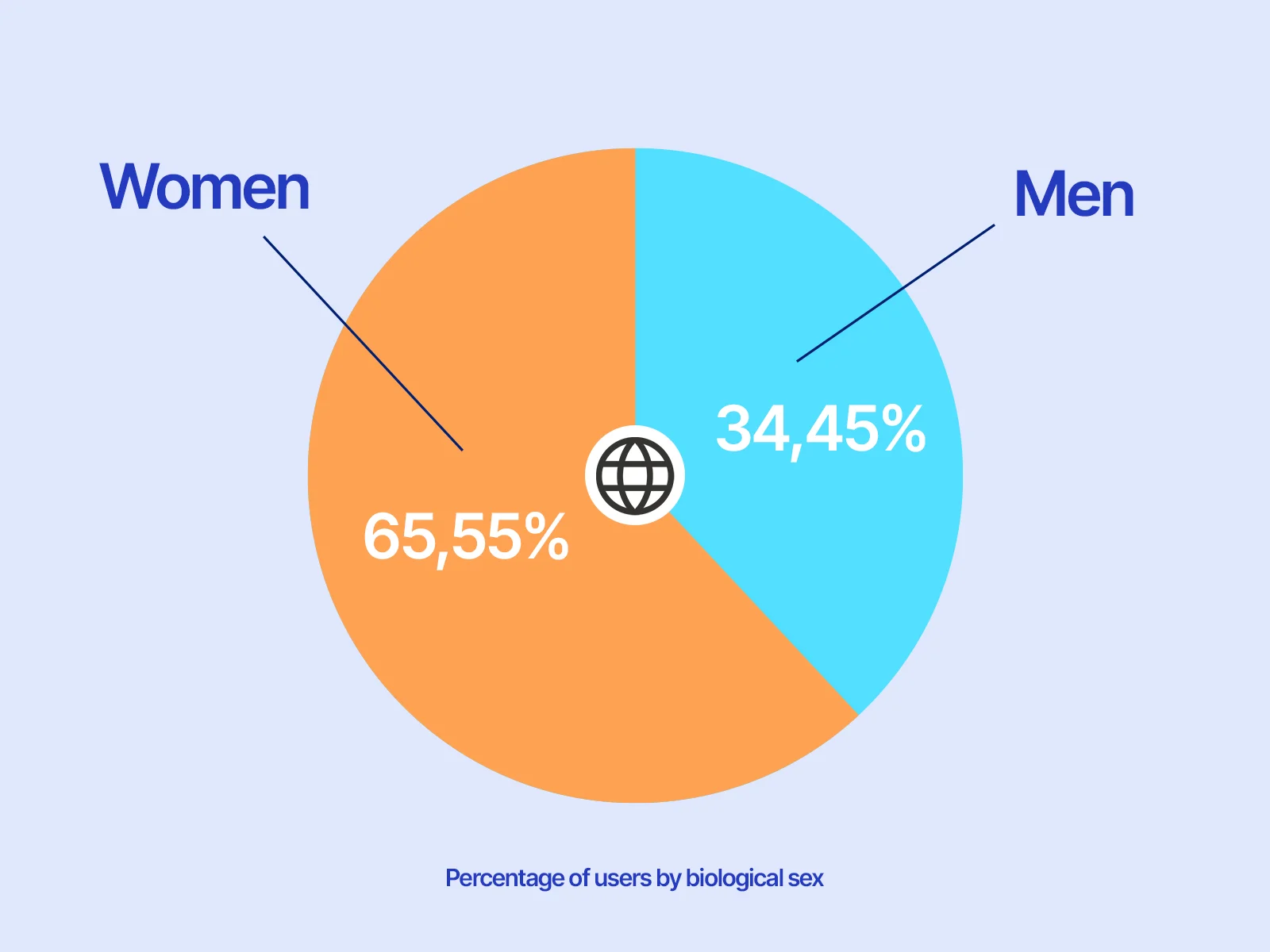
- Female users: 65,55% (152,394 users)
- Male users: 34,45% (80,089 users)
Looking at this same parameter for the United States, we see a similar trend, with female users being the predominate:
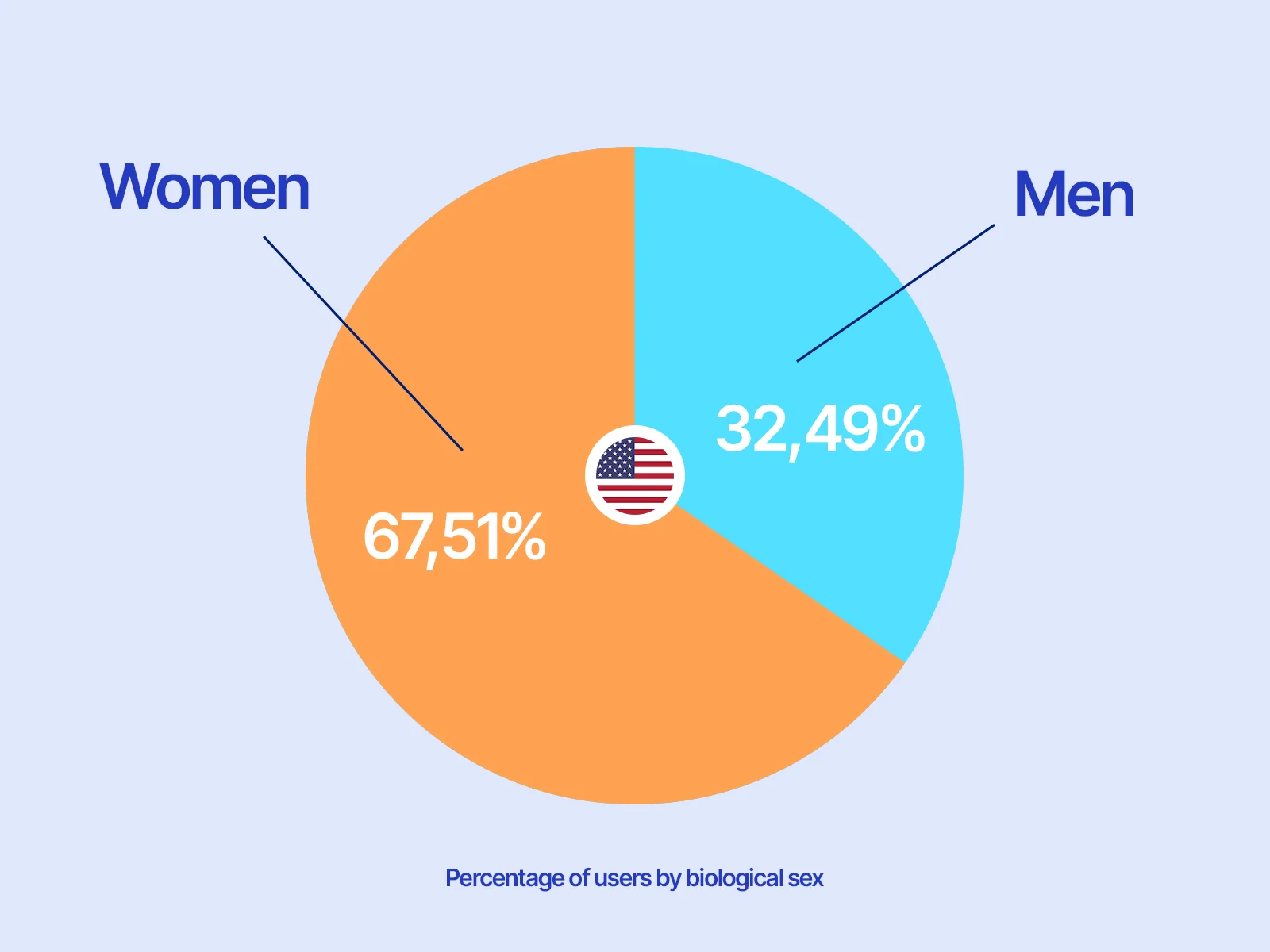
- Female users: 67,51% (66,752 users)
- Male users: 32,49% (32,063 users)
What conclusions can we draw from the biological gender statistics? Most likely, this skew towards female users can be explained by several factors, such as general motivation for playing, areas of interest, and life expectancy (according to the CDC’s National Center for Health Statistics, the average life expectancy for men in the US is 74.8 years, while for women, it is 80.2 years, based on 2022 data).
Regarding the type of population to which puzzle game players predominantly belong (large city, small town, suburb, rural area), it can be said that such data will vary significantly depending on the country of residence and the population's affluence.
For example, there is a significant percentage of urban population among users from Russia. For comparison, during the selected period, 36,393 unique users from Moscow played on the site, which is the highest figure among other localities worldwide — 2.17%. For clarity, here is the top 10 cities by the number of users:
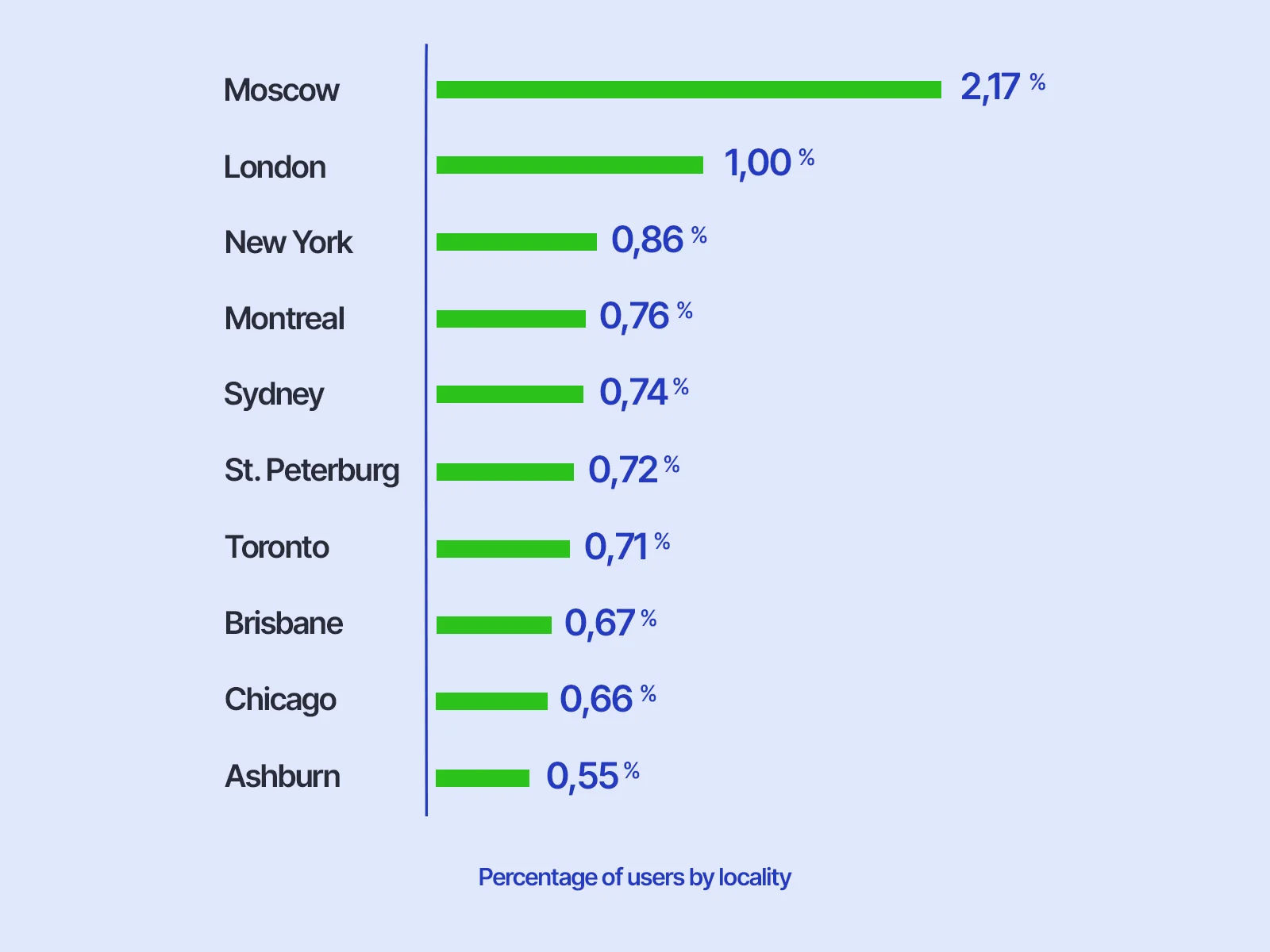
- Moscow: 2,17% (36,393 unique users)
- London: 1,00% (16,798 unique users)
- New York: 0,86% (14,377 unique users)
- Montreal: 0,76% (12,699 unique users)
- Sydney: 0,74% (12,484 unique users)
- Saint Petersburg: 0,72% (11,991 unique users)
- Toronto: 0,71% (11,882 unique users)
- Brisbane: 0,67% (11,189 unique users)
- Chicago: 0,66% (11,040 unique users)
- Ashburn: 0,55% (9,196 unique users)
As you can see, this statistic does not correlate with the previously provided data by country, where we observed a clear predominance of users from the US. It is also noticeable that several cities from Russia made it into the top 10. This is most likely due to the lifestyle: a significant portion of Russia’s population tends to live in large cities. At the same time, those living in rural areas or suburbs show less interest in such entertainment as online puzzles.
In contrast, despite the very high percentage of players from the US, only three major cities made it into the top 10. Based on this data, we can assume that in the context of the US and several other countries like Canada, a significant portion of players comes from small towns and suburbs. People over 50 often move to such places in search of a more peaceful and measured lifestyle, and it is this age category that makes up the majority of the audience for such services.
If we compare the ratio of players relative to the population size of a locality, we get the following data for the United States. The percentage of players from New York relative to the city's population (8.336 million) is 0.17%; Los Angeles (3.822 million) — 0.21%; Chicago (2.665 million) — 0.41%. At the same time, the percentage of players from smaller towns is generally higher. For example, Hilliard (37,114) — 0.60%; Lakewood (79,063) — 1.80%; Grand Junction (68,034) — 3.04%.
Since the US is more representative in terms of audience due to the number of users and area, if we take a map of the United States and shade the states based on the number of users, with darker shades indicating higher numbers and lighter shades indicating lower numbers, we get the following picture.
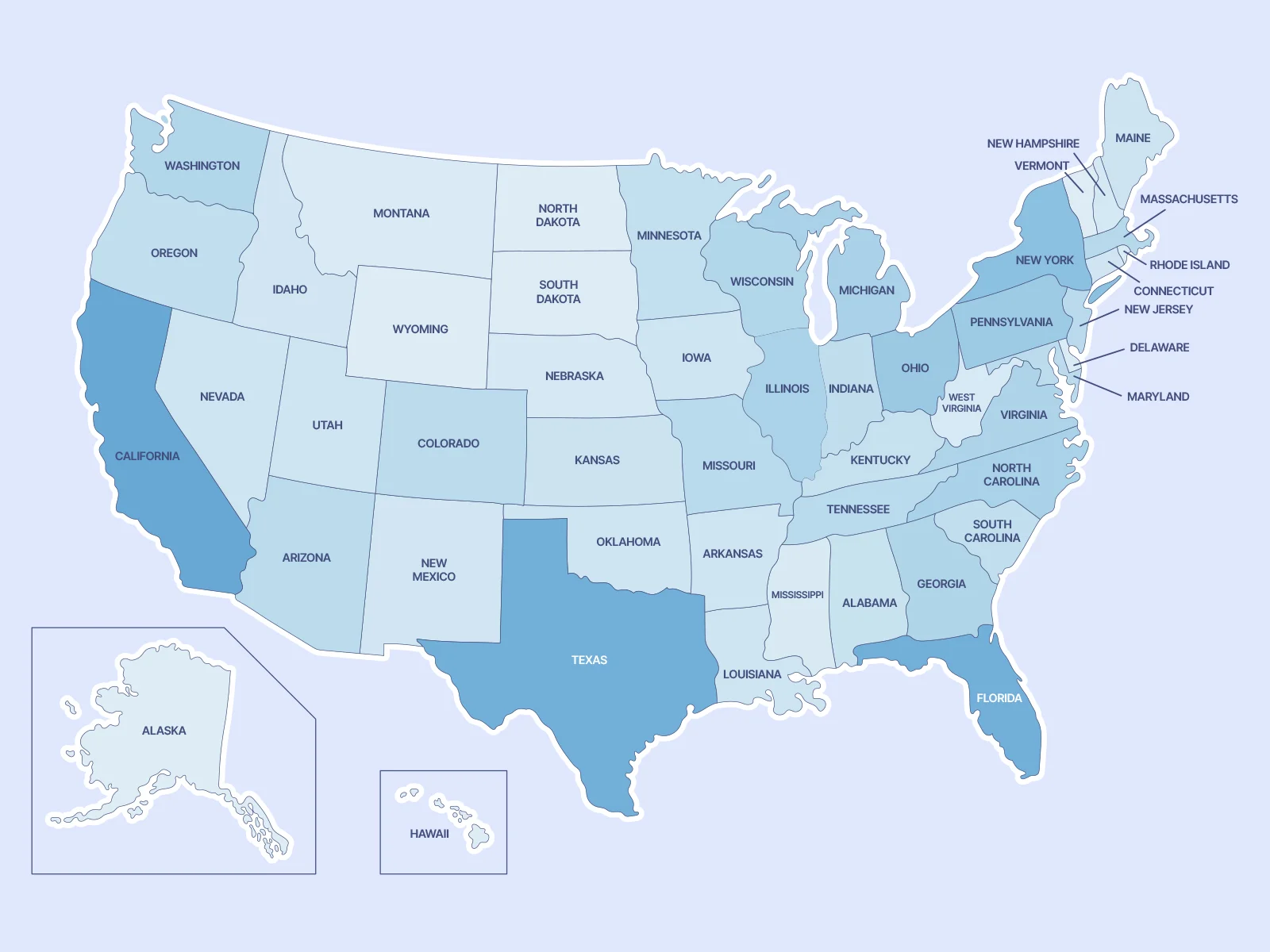
The states with the highest number of users are California, Texas, Florida, New York, Illinois, Pennsylvania, Ohio, Georgia, North Carolina, and Washington. The states with the lowest number of users are Montana and Wyoming.
According to the 2024 US Senate election results map, we can highlight the states that support Democrats: California, New York, Washington, Georgia, and Illinois — all of them have a high percentage of active users. We can also highlight states with a high percentage of users that support Republicans: Texas, Ohio, Florida, North Carolina, and Pennsylvania.
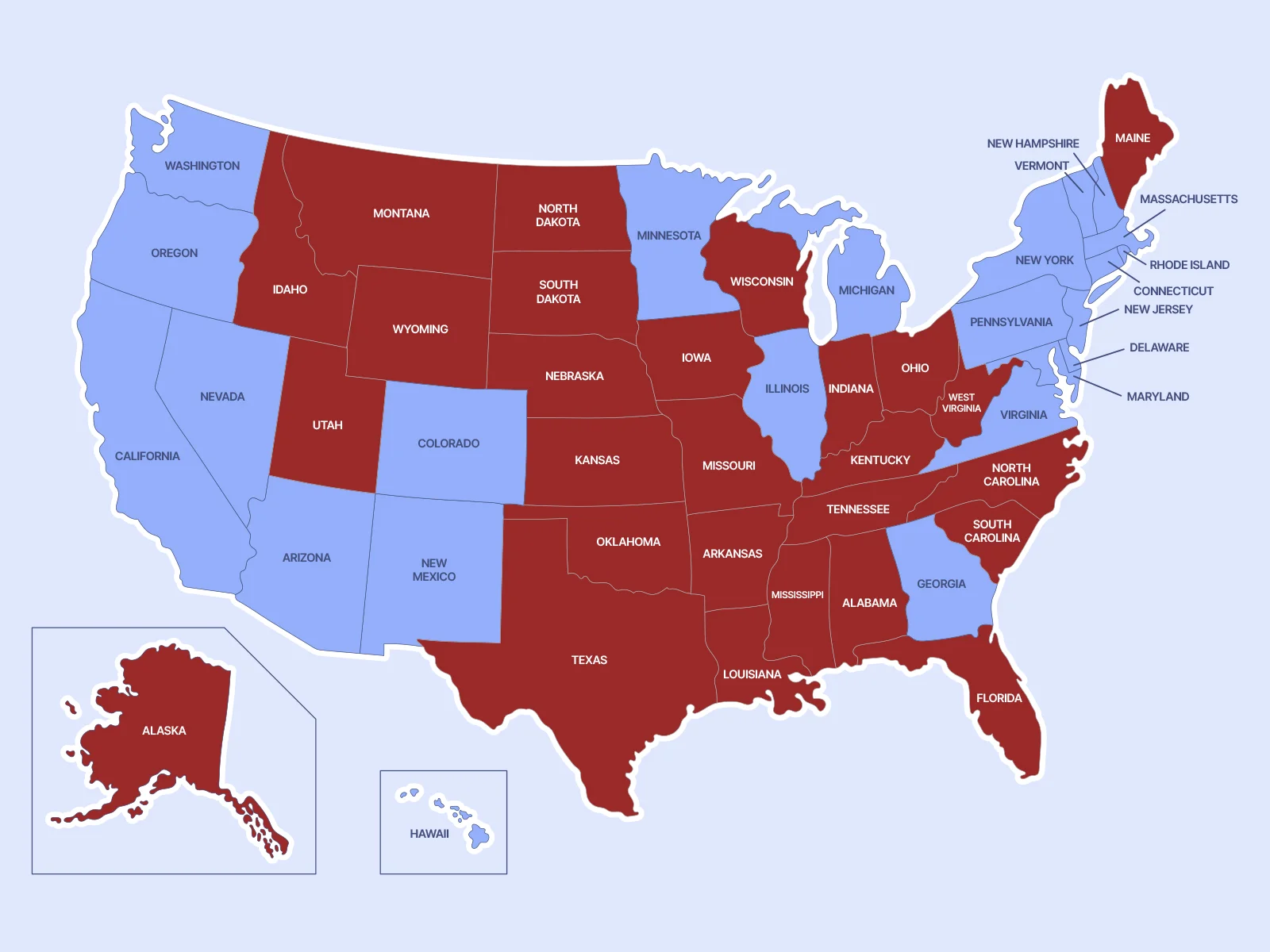
If we analyze the presented states, we can note the following. The number of users on puzzle game websites does not correlate with the political preferences of the states. Among the most populous states, there are both traditionally Republican and Democratic states, as well as states without a clear political stance. Therefore, it is not possible to identify a clear predominance of states supporting either Democrats or Republicans among the most active states in terms of user numbers.
It is also worth noting that the audience of the site themahjong.com covers all US states. The low level of visits from states like Montana and Wyoming, with populations of less than a million each, can be explained by their low population density.
The most populous locations in the US (578,826 unique users) are as follows:
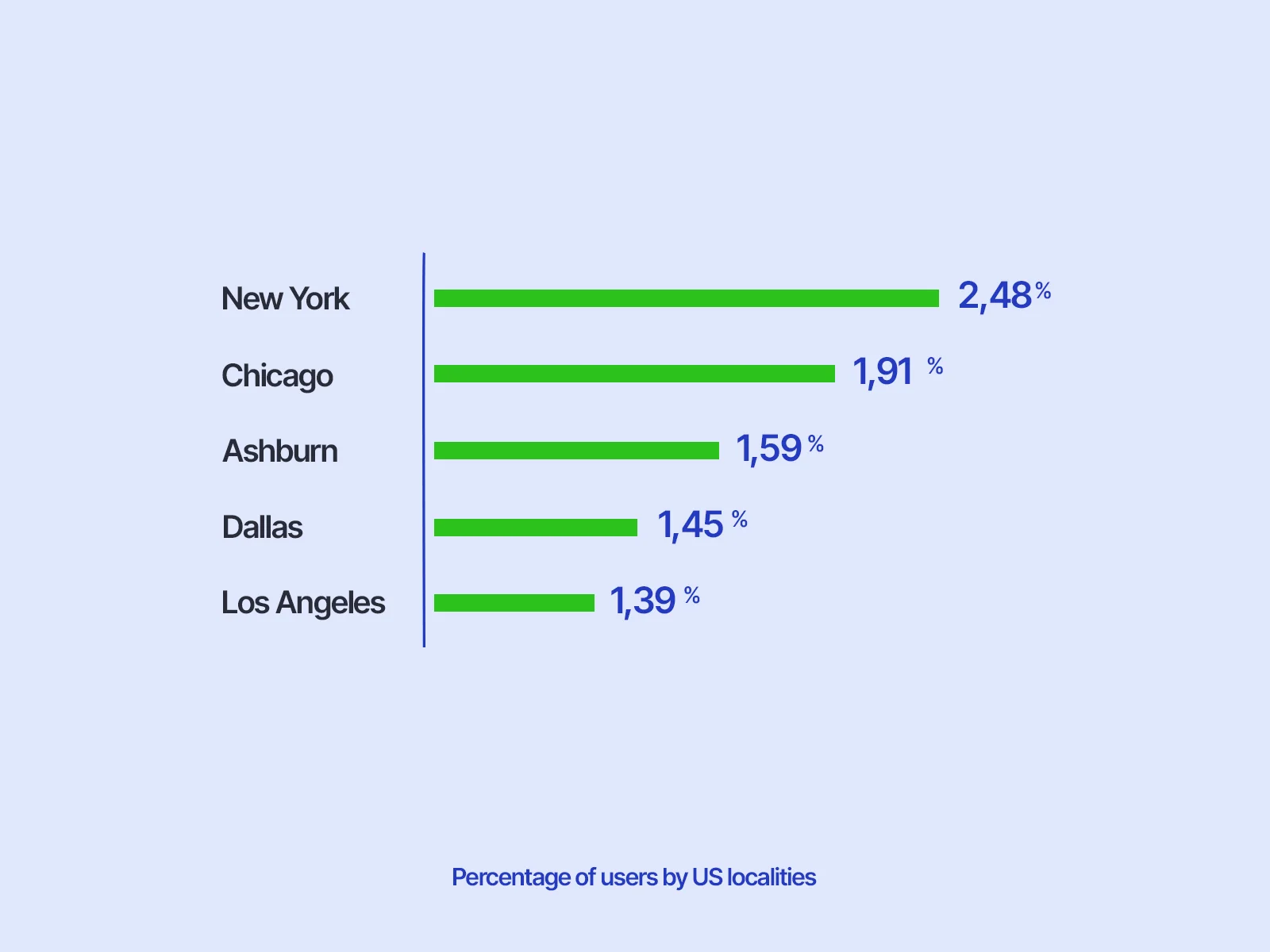
- New York: 2,48% (14,377 unique users)
- Chicago: 1,91% (11,040 unique users)
- Ashburn: 1,59% (9,196 unique users)
- Dallas: 1,45% (8,395 unique users)
- Los Angeles: 1,39% (8,065 unique users)
The least populous locations are Alpha (California) and Asbury Lake (Florida).
In conclusion, upon closer examination of the US, it is difficult to identify clear factors influencing the percentage of users on casual gaming websites, aside from demographic factors. No clear influence of a state's or city's political leanings was found. As mentioned earlier, the US is characterized by a higher percentage of players relative to the population size in smaller towns and rural areas compared to large metropolitan areas.
Summarizing this section as a whole, we can conclude that more than half of the audience of puzzle websites consists of elderly people. Typically, over 60% of users are female. The most common languages among users are English (56.30%) and Russian (11.24%). In terms of traffic volume, the highest share comes from the US (34.54%). It is worth noting that the statistics and conclusions may differ on similar projects from other companies due to search engine rankings. Therefore, the above conclusions require comparison with data from large web services with similar themes.
Factors Influencing the Popularity of Puzzle Game Services
When discussing the factors that influence the growing popularity of projects like themahjong.com, especially among the elderly, the following can be highlighted:
- Genre specificity
- Increased focus on health
- Social factor
- Demographic factor
Analyzing the specifics of casual games, particularly puzzles, we can note that they generally don't require much time to learn. These games are characterized by simple rules, measured gameplay, and simplified visual elements compared to other game genres.
For example, if we consider Mahjong Solitaire, in the classic version of the game, you need to match pairs of tiles, clearing the game board in the process. Learning the rules of the classic version doesn't take long, and players can quickly start the game.
The visual aspect is also an important factor in games of this type. According to the study "What Older People Like to Play: Genre Preferences and Acceptance of Casual Games" elderly audiences prefer simpler or cartoon-style designs, which are common in such projects. Online puzzles typically have modest visual effects and place less emphasis on image realism.
This "rule" of simplicity also applies to game control mechanisms. According to the above-mentioned article, simpler and more familiar controls, such as keyboard navigation or selecting objects with a mouse/touch, significantly impact the enjoyment and engagement of elderly users. This, in turn, influences the popularity of certain genres among this audience.
A significant influence on the popularity of puzzles is the fact that these types of games existed long before their electronic versions appeared. Sudoku or solitaire, for example, contributed to the "rooting" of games in this genre. Thanks to simple rules and straightforward visual design, puzzles were among the first games to be digitized, including online versions. It became much easier for users to access new puzzles since they could play them on a single device without leaving home.
It’s worth noting that some games in this genre are still pre-installed on the Windows operating system. However, in later versions, the design of these games changed, and some were removed. This created demand among users accustomed to the previous versions' design, who sought replacements for the removed games. This demand became one of the catalysts for the development of the online puzzle market.
It is also important to note that online puzzles do not require high-performance devices. Therefore, users generally have easy access to them from most internet-enabled devices. Combined with the gameplay's simplicity, this genre of games is one of the most popular for "killing time" while traveling or waiting in line.
In summary, thanks to the simplicity of gameplay, low device requirements, easy-to-understand rules, and the long-standing existence of the genre, casual games—puzzles in particular—occupy a significant share of the web games and apps market, continuing to attract new users who grew up during the rise of computer versions of games in this genre.
When it comes to the medical aspect, studies such as "Ageing Positively with Digital Games" show that gaming experiences have a positive effect on the mental and physical well-being of elderly people. In particular, a positive gaming experience helps with relaxation and stress relief, which benefits mental health.
Puzzles not only provide a relaxing effect on players but also help "train" the brain. These types of games require thoughtful moves, strategic planning, and calculations, which in turn train short-term memory and the ability to focus on tasks. It has been proven that regular gaming sessions reduce the likelihood of cognitive disorders. Specifically, in the case of Mahjong, regular gaming sessions significantly lower the risk of developing neurodegenerative diseases such as Alzheimer's, dementia, and other brain-related cognitive disorders.
Combined with the above, the overall trend of increased attention to mental and physical health creates a demand for cognitive training and drives the growth of casual games. This is also supported by feedback from users of themahjong.com, as well as data from related studies—many elderly players specifically choose online puzzles as a leisure activity to maintain brain function while also enjoying themselves.
Based on feedback data and statistics on the use of the "share" feature on the themahjong.com site, we can conclude that the 65+ age group actively shares their gaming experience and the game itself with their community. For example, in one piece of feedback received from users, a situation was described where a pastor at a church in the US recommended that his congregation use the themahjong.com service to maintain their mental health and train their brain's cognitive functions. This is not an isolated case.
Such a social factor not only increases interest in such sites but also shapes the audience of these services, as users come to them by recommendation. Additionally, there are successful practices where gamification strengthens social bonds between generations. Typically, a specific game is suggested, upon which participants learn together and share their experiences.
The demographic factor is no less important. It lies in the fact that the number of people over the age of 60 is increasing every year. According to the United Nations (UN) projections, the elderly population will grow significantly by 2030. The UN estimates that by this time, the number of elderly people worldwide will reach approximately 1.4 billion, accounting for about 16% of the global population. Based on the statistics mentioned above, we can already observe a significant predominance of the elderly audience (about 69% of all themahjong.com users are over 55) on online puzzle services.
If we combine the factors described above, such as the increased attention to health, the specifics of the genre, and the demographic factor, we can conclude that by 2040, the elderly population (those over 60) will include individuals familiar with games, and as a result, we can forecast an even more substantial increase in the popularity of games, particularly puzzles.
In summary, the growing popularity of online puzzles is influenced by the following factors: 1) genre characteristics; 2) the overall increase in attention to health; 3) the social factor; 4) the demographic factor. All of these factors significantly impact user motivation to play and shape the audience of such services. At the same time, the significant growth of the elderly audience, who are already familiar with games, stimulates demand and the popularity of puzzles like Mahjong.
Portrait of the Average Mahjong Solitaire Player
Summarizing all of the above, we can form a tentative image of the average player on the themahjong.com platform. Based on the age group statistics, we can assume that this user is approximately 65-70 years old, as this age group is the largest and makes up just over half of all users on the site (50.35%).
Given the chosen age group, we can assume that our average user is already retired, as in the majority of the countries generating the main traffic for our game, this age corresponds to retirement age.
Regarding biological gender, and once again looking at the statistics, our average user is female (65.55%).
Analyzing the countries that generate the main traffic for our audience, we found that the largest traffic comes from the US (34.54%). Meanwhile, the next largest country, Russia, accounts for only 9.74%. From this, we can conclude that the average user is from the US, and based on the statistics, likely from one of the following states: California, Texas, Florida, New York, Illinois, Pennsylvania, Ohio, Georgia, North Carolina, or Washington.
If we combine all this data into a single profile, we can conclude that the average themahjong.com player is an elderly woman aged 65 to 70, enjoying her retirement and spending part of her leisure time playing Mahjong, residing in the United States. Based on the map of states mentioned earlier, she most likely lives in one of the following three states: California, Texas, or Florida, as the percentage of users from these states is the highest.

Using AI-based image generation tools and applying the description of the average player mentioned above, we were able to create a tentative visual representation of this elderly woman from the US. It should be noted that this image is a composite, based on the available statistics. Any possible visual resemblances to specific individuals are purely coincidental, as the image was created with AI. It is also important to emphasize that no racial specifics, such as skin color, hair color, or other detailed characteristics, were included in the request.
Conclusion
In the course of our research on the audience of the themahjong.com website, we identified the following. According to statistics collected from September 1, 2023, to September 1, 2024, we can conclude that more than half of the puzzle game website audience consists of elderly people. Approximately 60% of users are women. The most common languages among users are English (56.30%) and Russian (11.24%). The majority of traffic comes from the US (34.54%). It is important to consider that statistics and conclusions may vary for other projects due to search engine ranking specifics, so these results should be compared with data from major web services of similar themes.
If we take a closer look at the US audience, we can conclude that the trend of a clear predominance of users over the age of 55 is also observed in the US. Similar to the predominance of female users, there are no clear factors, besides demographics, that significantly affect the percentage of casual game users. No clear influence of a state's or city's political orientation was found during the study. As mentioned earlier, the US is characterized by a higher percentage of players relative to the population size in smaller towns and rural areas compared to large metropolitan areas.
During the research, we identified the following factors influencing the growing popularity of online puzzles such as Mahjong: genre characteristics, increased attention to health, social, and demographic aspects. All these factors significantly motivate users and shape the audience of such services. In particular, the significant growth of the elderly audience, already familiar with games, contributes to the increasing demand and popularity of these puzzles.
Our team also made an attempt to outline the profile of a typical Mahjong player on our site. This person is presumably an elderly American woman between the ages of 65 and 70, who is enjoying her retirement and spends part of her leisure time playing Mahjong.
Other Mahjong News
Try out the Mahjong gameplay practices on TheMahjong.com
Playing Mahjong at TheMahjong.com offers not just an interesting and exciting pastime, but also an excellent way to improve cognitive skills. Here, you can refine your logical thinking, planning, and visual perception. We invite you to discover this unique world of Mahjong Solitaire and dive into an exciting adventure at TheMahjong.com!


